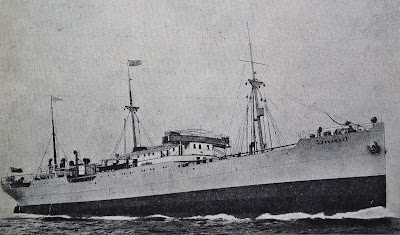 |
| The Jutlandia, built by Barclay, Curle & Co in 1912. Note the lack of a funnel. |
In February 1912 the Danish East Asiatic Company's Selandia became the first ocean going motor vessel in the world. The Selandia ( including its two diesel engines) was built by Burmeister and Wain in Copenhagen, which already in 1894 had began to co-operate with the inventor Rudolf Diesel.
In addition to the Selandia, the Danish East Asiatic Company had ordered two sister ships to be delivered the same year. Probably due to lack of capacity at Burmeister and Wain, one of the ships, the Jutlandia, was built on the Clyde in Scotland by Barclay, Curle & Co. The Jutlandia was handed over to the Danish owners in May, 1912.
The good performance of first ocean going diesel ships made the East Asiatic Company soon switch completely from steamers to diesel powered ships, an example followed by more and more shipowners all over the world:
"In 1914 there were fewer than 300 dieselpowered vessels in service with an aggregate tonnage of 235 000 grt; a decade later the fleet had grown to some 2000 ships of almost two
million grt; and by 1940 the total tonnage had risen to 18 million grt embracing 8000 motor ships.
Between the two world wars the proportion of oil-engined tonnage in service thus expanded from 1.3 to 25 per cent of the overall oceangoing fleet. By 1939 an estimated 60 per cent of the total tonnage completed in world yards comprised motor ships, compared
with only 4 per cent in 1920."
(Pounder’s Marine Diesel Engines and Gas Turbines Eighth edition)
Basic information on the Jutlandia:
- Built: Barclay, Curle & Co. Ltd., Glasgow (Yard no. 490)
- Tonnage: 7600 dwt. 4874 gt.
- LBP: 370'
- Beam: 53'
- Depth from Shelterdeck: 30'
- Diesel: 2 pc. 8 cyl. B&W 4-stroke engines. 2500 IHP. Twin screw.
- Service Speed: 11 knots
No comments:
Post a Comment